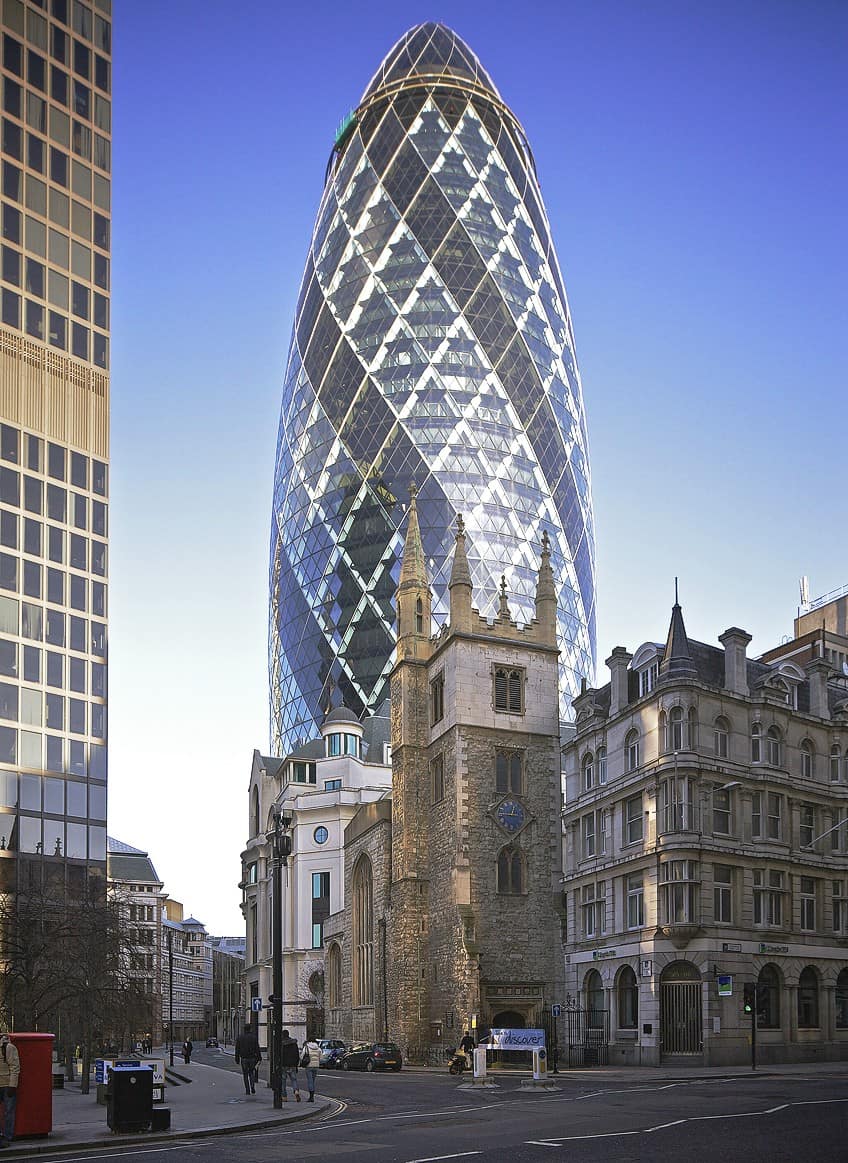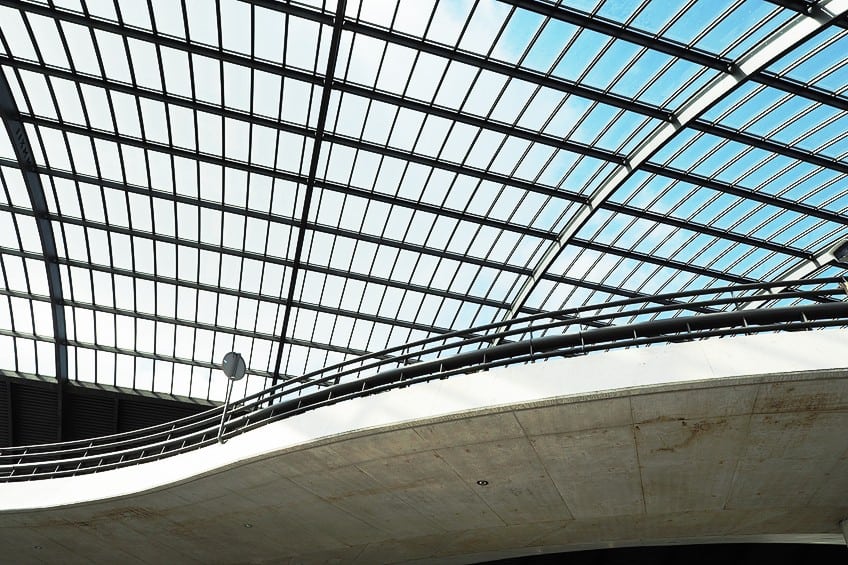Geometry in Architecture – The Art of Symmetry
Geometry is an integral aspect of architecture, and this article will focus on that while also asking: “How is geometry used in architecture?”. We will discuss some of the central concepts of geometry in architecture to try and answer that question, alongside discussions of the importance of geometry in architecture, some of the most commonly used geometric shapes in architecture, and geometric architecture in general. If you have wondered about geometry in architecture and wish to know more about it, then this is the place to be!
Table of Contents
A Look at Geometry in Architecture
Geometry is one of the oldest branches of mathematics. This is without it being related to architecture at all, but about as early as geometry existed, so did architecture. While we may have needed more formalized and written accounts of geometry so that we could better use it in architecture, a basic understanding of how shapes work has always been fundamental to all forms of architecture. For instance, when ancient people needed to construct a rudimentary shelter to hide from the rain, they would still need to understand that a square/rectangular shaped material would be needed for the roof and that roof would need to be held up with other shapes of some kind, such as cylinders or square beams.
Geometry is the branch of mathematics that is concerned with shapes.
It works with lines, points, and angles of both 2D and 3D shapes. An understanding of this branch of mathematics is needed for many different fields and architecture is no exception, but how is geometry used in architecture, you might ask. Well, it depends on the kind of structure that needs to be designed. For instance, the more complex the structure, the more complex the need for geometry. The above example of a rudimentary shelter is a very basic type of architecture. We can all essentially do this. If we have some wood, we can prop something up on top of those pieces of wood to make a shelter. However, the shelter will probably fall over at some point unless we learn how to better reinforce it. We may instead want to pile stones on top of each other in a specific formation to improve the sturdiness of the structure. We will get into far more detail in the coming article though.

What is beneficial to know though is that geometry is ancient. The earliest instances of geometric workings being written down can be traced back to ancient Greece, and the ancient Roman architect, Vitruvius, further solidified the place of geometry in architecture by claiming that buildings required certain proportions. This means that Vitruvius, and other architects, took geometry out of books and put it into practice. They understood how shapes could allow buildings to stand on their own, reach great heights, and a whole other array of architectural marvels that will be discussed below. However, before we get started, it should be noted that this will not be a highly technical look at geometry in architecture, and if you are looking for equations, then a mathematics textbook may be a better place to start looking.
For this piece, we’ll start with some of the central concepts that you might find in geometry in architecture.
Central Concepts in Geometry in Architecture
The best way to open our discussion about geometry in architecture is to examine some of the primary concepts that can be found in geometry in the first place. We will look at each of these in brief to try and understand why they are needed in geometry in architecture. This will not be an overly technical examination of these concepts though, and rather an overview of how they are related to architecture.

Angles
Angles are one of the earliest things we learn about when it comes to geometry in general because it entails the closeness between two lines measured in degrees. Learning how to calculate the angle or working with angles to calculate other parts of a shape, is one of the most basic aspects of geometry in a school setting. In architecture, on the other hand, understanding how angles can be used is of integral importance as it allows for the design of structurally sound buildings while also allowing for the development of aesthetically pleasing structures.
For instance, a right angle is generally used for the design of building frames because it is far more structurally stable.
Lines
The concept of a line is probably one that doesn’t need much explanation seeing as we all generally know what a line is. A line entails a one-dimensional length between two points, and lines can be connected to other lines to produce shapes. The line is pretty much one of the most basic aspects of geometry in general.

When it comes to the use of the line in architecture, it is necessary to use lines to define various aspects of a building, such as the space, direction, and patterns in said structure. Different lines can present us with different general feelings or ideas, such as horizontal lines being used to suggest length and stability while vertical lines can be used to suggest height or even grandiosity.
Perspective
Our general view of this term is as a way of seeing something. However, perspective has a specific definition based on where it can be found, but it generally entails the representation (or illusion) of three-dimensional images on a two-dimensional surface. In terms of architecture, this aspect of geometry is used in the planning of structures on two-dimensional surfaces, such as paper, to create a representation of the three-dimensional image that is to be built later.
This allows architects who are designing structures to better visualize the way in which their design might appear when it is presented to us when it has actually been constructed.
Points
Another of the most basic elements of geometry in general is the point. This allows for the connection of lines to one another. Every shape is made up of a number of points. For instance, a triangle has three points, and a square has four points. Wherever points are connected to produce a shape, they also lead to the creation of angles between the points.

When it comes to the use of points in architecture, it is a necessary and basic element of design. Architects need to know where the different shapes of a building start and end, such as the boundaries of a floor plan or the height of a wall. All of these are made up of shapes, and shapes are made up of points.
Proportions
This idea is one that can be found in many types of architecture, but in basic terms, proportion refers to the relationship between different points and shapes. A harmonious proportion would mean one in which the shapes are related to one another in some way. For instance, a square making use of a square half its size on top of it, and that square having a square half the size of it above would lead to a more proportional image.
If there was no real rhyme or reason as to why the different parts were connected to one another, then it would lack proportionality.
Proportion is very important in many types of architecture because it refers to the idea of a harmonious connection between different parts of a structure. The height of a roof might be half the height of the wall or something similar, and this allows for a more proportional design. This is especially prevalent in examples of Classical architecture, and the forms that have been inspired by it, such as Renaissance and Neoclassical architecture.
Shapes
This is another concept that is immensely basic, and we generally know a number of different shapes without having to know a single thing about geometry. Shapes are forms made up of lines and points, and there are many different types of shapes, such as squares, circles, rectangles, triangles, and so on. While those kinds of shapes are the basic forms, there are also many shapes that are more complex, such as polyhedrons.

The use of geometric shapes in architecture is one that should be fairly obvious. All buildings are made up of shapes. A wall is, ultimately, a rectangle. A roof can often be designed as a triangle on one side with a rectangle on the other side. Various elements might use circular designs, such as the circular nature of arches. Shapes are everywhere in the geometry in architecture.
Solids
While we all know what shapes are, we also know what solids are. We may not know the term, as it is not as commonly used as “shape”, but we all still know them. In this case, a solid is a three-dimensional form that has been created through the use of shapes. This was actually briefly mentioned above because when we combine certain shapes, we find that we have produced solids.
For instance, a square for the floor and four triangular walls lead to a pyramid.
The use of solids in architectural geometry is an obvious one. While buildings are all made up of shapes, shapes are ultimately two-dimensional. They are given a solid structure when they are combined with one another. Some of the most common solids include cubes, spheres, cylinders, and cones. These are all found in buildings.
Symmetry
The concept of symmetry is one that you will find in everyday language, and we often see it as being detached from geometry, but it is part of it. Symmetry refers to the reflection of shapes, such as our faces being (mostly) symmetrical images of one another, with one side being identical to the other side along the y-axis.

When it comes to symmetry in architecture, we can find this concept everywhere. We often reflect shapes against one another on different axes to produce a more harmonious image. For instance, if we have a design on one side of a wall on a building, we may want a mirrored version on the other side of that wall. We do not want it to be exactly the same but reversed.
Tessellation
This is a term that is less commonly known than some of those that we have discussed above. However, the concept is still not particularly difficult to understand. In basic terms, tessellation in geometry refers to the way in which geometric shapes can be tiled alongside one another with gaps or overlaps between them. This is used for the creation of patterns, such as very basic ones like grids, and we can see a kind of tessellation when it comes to the use of floor tiles in homes.
They are generally the same shape and size and layered alongside one another to create a certain grid-like image.
The Importance of Geometry in Architecture
So, why is geometry used in architecture? Why is it so important? Well, without geometry, buildings would not be able to stand. Architects need to understand how the different elements of geometry, and how the different geometric shapes, can be used in the design and construction of buildings. Architects need to understand squares, rectangles, circles, curves, triangles, and polyhedrons to understand how they can be used, how their weight is distributed, how much support they provide to a structure, and so on.
Without geometry in architecture, buildings would, quite simply, collapse.
This is why geometric rules have become integral to architecture. We cannot do without them. This is also why mathematical skills of this particular variety are considered to be highly necessary for any architect to have any hope of doing their job. While a building can be built without understanding high-level geometric ideas, a basic understanding is always necessary. The more sophisticated a structure becomes, the more sophisticated the geometry for it needs to be. The entire concept of geometry in architecture is needed because it can be used to determine the shape and size of structures, understand where a structure should and could be placed, allow for the planning of spatial elements of a structure, produce balance and symmetry, and, of course, geometry can even be used for less structural and more decorative purposes.

The importance of geometry in architecture is impossible to overstate. Without geometry, there would be no architecture. These two concepts are inseparable from one another, and they are intimately tied. This also means that those who want to pursue a professional career in architecture need to understand mathematics and, specifically, geometry, to be able to do their jobs, but geometry is everywhere around us. It exists in nature and in everything humans have created.
So, it shouldn’t be too difficult to be inspired by the geometry that exists everywhere.
The Term “Geometric Architecture”
When it comes to the idea of any kind of “geometric architecture”, we often have to determine what exactly we mean by this concept. All architecture makes use of geometry, but some architecture is more geometrically oriented than other types of architecture. For instance, the styles of architecture that were highly influenced by Classical architecture are often a lot more rigidly geometric in their design. They usually make use of highly proportional designs and have a clear desire to use symmetry and other geometric elements in their buildings.
This would be in juxtaposition to something like Baroque architecture, in which the interiors of these kinds of buildings are often far more irregular.
They are meant to be awe-inspiring and dazzling to the eye. Highly geometric designs in a building are not dazzling to the eye because they feel “correct” in a sense. But we could argue that this is simply another way to use geometry. It can be used to produce unwieldy and disorientating shapes rather than harmonious ones. This is especially prevalent in architectural styles like Deconstructivism. This style makes use of strange and elaborate shapes, and they often curve around one another in a non-harmonious sense. They are strange and difficult designs, but they are often highly geometric.

However, these architects use geometry to disorient rather than create something ordinarily and traditionally pleasant to the eye. So, ultimately, the idea of “geometric architecture” is a bit of a strange term as all architecture is geometric in its design. It all simply depends on how architects choose to make use of geometry in architecture. The term is not all that useful or beneficial, but it is one that may be used.
We have examined many different aspects of geometry in architecture today. We have looked at why this field is so important in architecture, what some of the most common geometric shapes in architecture happen to be, and the many uses of geometry in architecture. So, if you wanted to know about how geometry and architecture are connected to one another, this should have given a good general overview. However, if you want to learn some of the more technical specifics, you may need to open a mathematics textbook and start from the beginning.
Frequently Asked Questions
What Is Geometry in Architecture?
Geometry in architecture is the same as geometry anywhere else, except that it is specifically applied to architecture. So, it may be more pertinent to ask about geometry itself, which is a branch of mathematics that is concerned with points, angles, and lines in shapes. This is one of the most important parts of mathematics when it comes to architecture because without geometry, we would not know that buildings would be able to stand at all. This ancient branch of mathematics is fundamental to architecture, and there could be no architecture without it.
How Is Geometry Used in Architecture?
Geometry is used in architecture in a variety of ways. It can be used to determine geometric shapes in architecture, as well as the size and placement of the various elements of a structure. All buildings are ultimately made up of shapes, and understanding how different shapes, such as squares and circles, contribute to aesthetics, structure, and support is necessary to be able to work as an architect. Geometry in architecture becomes integral when it comes to planning buildings, developing symmetrical structures, and decorating buildings.
What Are the Different Geometric Shapes in Architecture?
An answer to this question is actually quite simple because it can also be applied to shapes in general, but the different types of geometric shapes in architecture include triangles, squares, rectangles, circles, polyhedrons, and curves. These are the same kinds of shapes that exist everywhere. However, when it comes to geometry in architecture, we need to understand how the different shapes can be used in the design and construction of buildings, such as knowing where weight is distributed in a triangle versus a square, and so on. This also plays into how geometry is used in architecture, as it is an immensely important field of mathematics for the design of structures.
What Is Geometric Architecture?
This expression could refer to a number of things as geometric shapes can be found in all architecture. All buildings are made up of shapes, meaning that geometry in architecture is everywhere. However, the phrase can also refer to specific types of architecture that focus very specifically on aspects of geometry. For instance, Classical architecture was oriented around proportion and symmetry, and these are both aspects of building design that require a sophisticated understanding of geometry. Although, geometric architecture can also refer to more modern forms of architecture that are heavily oriented around shaped designs, such as Deconstructivist architecture.
What Are the Origins of Geometry in Architecture?
We could argue that geometry has been integral to architecture since before geometry was a formalized branch of mathematics, as a basic understanding of shapes is necessary to construct even the most rudimentary of shelters. However, geometry in architecture became far more prominent in ancient Greece when the earliest rules of geometry were first written down. Geometry in architecture would become even more pronounced in the Roman Empire because of figures like Vitruvius, who stated that buildings needed to make use of very precise geometric ratios. Ultimately, geometry in architecture has been around for about as long as architecture has been around. They cannot be separated from one another.
Justin van Huyssteen is a freelance writer, novelist, and academic originally from Cape Town, South Africa. At present, he has a bachelor’s degree in English and literary theory and an honor’s degree in literary theory. He is currently working towards his master’s degree in literary theory with a focus on animal studies, critical theory, and semiotics within literature. As a novelist and freelancer, he often writes under the pen name L.C. Lupus.
Justin’s preferred literary movements include modern and postmodern literature with literary fiction and genre fiction like sci-fi, post-apocalyptic, and horror being of particular interest. His academia extends to his interest in prose and narratology. He enjoys analyzing a variety of mediums through a literary lens, such as graphic novels, film, and video games.
Justin is working for artincontext.org as an author and content writer since 2022. He is responsible for all blog posts about architecture, literature and poetry.
Learn more about Justin van Huyssteen and the Art in Context Team.
Cite this Article
Justin, van Huyssteen, “Geometry in Architecture – The Art of Symmetry.” Art in Context. November 13, 2023. URL: https://artincontext.org/geometry-in-architecture/
van Huyssteen, J. (2023, 13 November). Geometry in Architecture – The Art of Symmetry. Art in Context. https://artincontext.org/geometry-in-architecture/
van Huyssteen, Justin. “Geometry in Architecture – The Art of Symmetry.” Art in Context, November 13, 2023. https://artincontext.org/geometry-in-architecture/.









